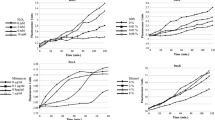Abstract
Effects of ionizing radiation (0.1–500 Gy) on recombinant Escherichia coli cells containing the stress promoters recA, grpE, or katG, fused to luxCDABE, were characterized by monitoring transcriptional responses reflected by the bioluminescent output. The minimum dose of gamma-irradiation detected by E. coli DPD2794 (recA::luxCDABE) was about 1.5 Gy, while the maximum response was obtained at 200 Gy. The amount of emitted bioluminescence increased proportionally with the gamma-ray doses which were found to elicit a DNA damage response in a range of 1–50 Gy. In addition, the cell growth rate was severely, but transiently, retarded by about 50 Gy. Quantification of the gamma-ray dose may be possible using the recA promoter fusion, since linear enhancement of the bioluminescence emission with increasing gamma-ray dose was observed. Other irradiated strains (50 Gy) responsive to either oxidative stress (DPD2511, katG::luxCDABE) or protein-damaging stress (TV1061, grpE::luxCDABE) did not display an increased bioluminescent output, while DPD2794 irradiated by the same dose of gamma-rays gave a significant bioluminescent output. This indicates that the recA promoter is the one most suitable for developing a biosensor for ionizing radiation.
Similar content being viewed by others
Author information
Authors and Affiliations
Additional information
Received: 8 April 1999 / Accepted in revised form: 25 November 1999
Rights and permissions
About this article
Cite this article
Min, J., Lee, C., Moon, SH. et al. Detection of radiation effects using recombinant bioluminescent Escherichia coli strains. Radiat Environ Biophys 39, 41–45 (2000). https://doi.org/10.1007/PL00007683
Issue Date:
DOI: https://doi.org/10.1007/PL00007683




